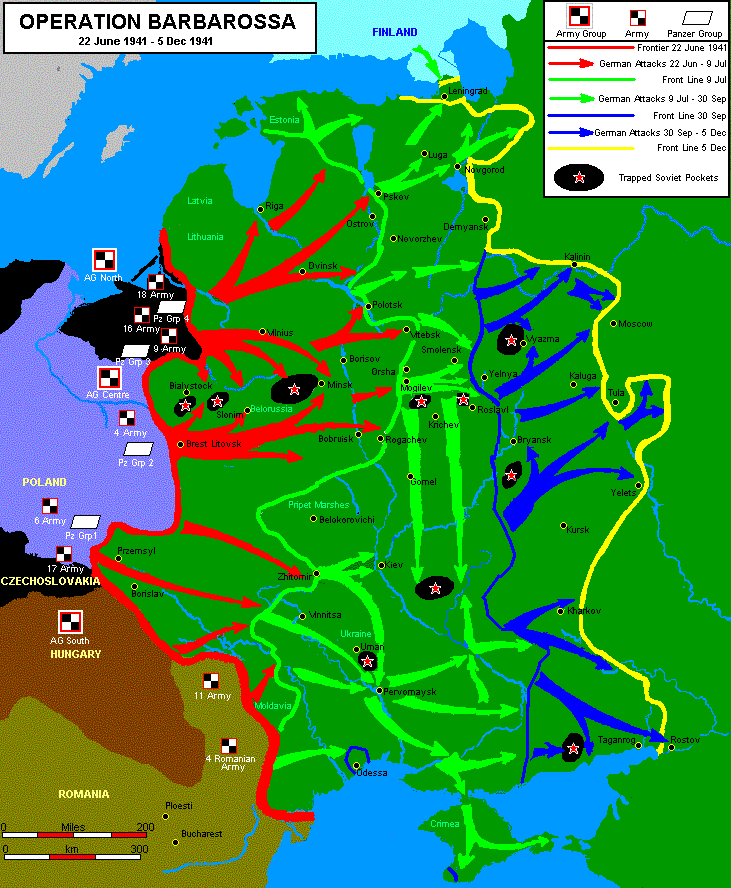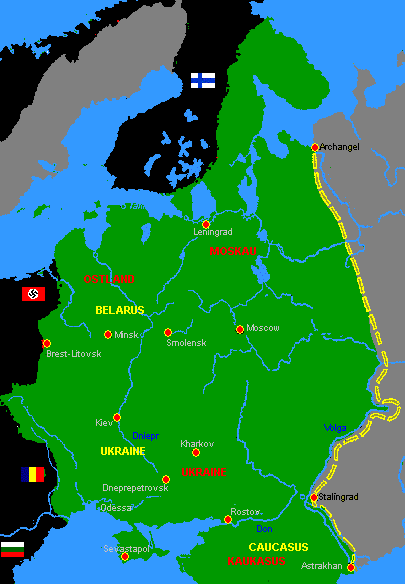THE GERMAN MILITARY PLANThe
German invasion force would organize into three Army Groups (which would later be
increased to five), each containing about 1 million men and divided into 3 or 4 Armies,
organized and commanded as below.
Typical Army Group
Organization - June 1941

Commander - Generalfeldmarschall |
Infantry Army -
200,000 men

Commander - Generaloberst |
3 to 4 armies under command of the Army
Group |
Infantry Corps - 60,000 men

Commander - General der Infanterie (etc.) |
Armoured Corps

Commander - General der Infanterie (etc.) |
From 2 to 5 Corps per Army, either armoured
or infantry |
Division - 20,000 men
 
Commander - Generalleutnant or Generalmajor |
Division - 20,000 men
 
Commander - Generalleutnant or Generalmajor |
From 2 to 7 Divisions per Corps. |
There were several types of Divisions:
| Infantry |
3 Infantry Regiments |
| Security |
1 Infantry Regiment |
| Light Infantry |
2 Infantry Regiments |
| Mountain |
2 Mountain Regiments |
| Cavalry |
3 mounted Regiments |
|
Armoured Corps were made up of two types of
Divisions:
| Panzer |
1 Armoured and 2 Motorized Rifle
Regiments |
| Motorized Infantry |
Two Motorized Infantry Regiments |
|
There were several wartime changes to the Divisions. The only Cavalry division was converted to a Panzer Division in
late 1941.
The Motorized Rifle Regiments of Panzer Divisions were redesignated
"Panzer Grenadier" in late 1942, as were Motorized Infantry Regiments.
Infantry Regiments were also redesignated "Grenadier" Regiments, but Infantry
Divisions retained that designation.
Panzer Groups were similar, but heavy in tank units
and were later redesignated Panzer Armies. |
The comparative strengths of the two
armies were as follows (source: John Ellis, Brute Force)
| 22 June 1941 |
Axis |
Soviet
(not including eastern forces not facing Germans) |
| Men |
3,150,000 Germans
530,000 Allies * |
3,000,000 |
| Tanks |
3,332 |
12,000 |
| Artillery |
7,184 |
5,900 |
| Military Aircraft |
2,770 |
10,000 |
* includes 18 Finnish Divisions, 14 Romanian Divisions, 3
Slovakian Divisions, 1 Hungarian Division, 3 Italian Divisions (as of 7 Aug 1941) and 1
Spanish Division (as of 1 Sep 1941) |
COURSE OF THE WAR
(German operation names are in blue, Russian
in red).
OPERATION BARBAROSSA
(Unternehmen Barbarossa)
Barbarossa (Red Beard) was a
nickname for Frederick I, who lived from 1121-1190 and was one of Germany's most famous
emperors. The name was given to the overall invasion of the Soviet Union.
German Objectives:

Süd
|
Army Group South - with 3
German Armies, a Romanian Army and a Panzer Group - was ordered to take Kiev and the
Dnieper River Valley, with the goal of encircling and destroying all Soviet forces between
the Pripet Marshes in central Russia, and the Black Sea. |

Mittel
|
Army Group Centre - with 2
German Armies and 2 Panzer Groups - was ordered to take the traditional invasion path from
Warsaw through Smolensk to Moscow, the two armoured groups to meet on the upper Dnieper,
the ultimate objective being the capture of Moscow. |

Nord
|
Army Group North - with 2
German Armies and a Panzer Group - was to advance northeast towards Leningrad, pinning
Soviet places in the Baltic regions in place. |
Other forces -
a Finnish army group was tasked to occupy the Karelian isthmus and Lake Onega front, to
threaten Leningrad from the north. In the Arctic, German forces of the Norway Army
were to cut the Murmansk railway.
The campaign was expected to
take four months at most.
Soviet Defenses:
Soviet forces were deployed
close to the western frontier, in occupied areas such as Poland, Bessarabia, and the
Baltics, and divided into Military Districts. Upon the onset of hostilities, the
forces in the Military Districts were grouped into Fronts, the equal of a German Army
Group. Some 3,000,000 troops were mobilized in the west, with 1,000,000 elsewhere in
the Soviet Union.

In the early hours of 22 June
1941, along a 2,000 mile front, and preceded by artillery barrages and small commando
actions, the German Army went into action in the Soviet Union. With complete
tactical surprise, the invasion force made spectacular advances and was able to acheive
large scale encirclements. The Red Air Force was by and large destroyed on the
ground in the early hours of the invasion and Soviet commanders were restricted in their
actions by Stalin, who held out hope that a mistake had been made and did not want to
provoke the Germans.

Nord
|
The German armies in Army
Group North advanced more slowly than in the central and southern regions of the front,
due both to errors and difficult terrain. Leningrad is surrounded on 19 August,
beginning the longest siege in military history. Finnish troops in the arctic also
advance swiftly, recovering territory they lost in the Winter War - then refusing to go
further. German troops in the extreme north don't advance at all, and the Murmansk
railway remains uncut.
|

Mittel
|
On June 28, Minsk was
captured. On 3 July, Stalin called for a scorched earth policy - no buildings,
bridges, or resources were to be allowed to fall into enemy hands. On 10 July, the
Dniepr River was crossed, and on the 15th Smolensk was taken. Large numbers of
Soviet soldiers fell into German hands - 290,000 at Minsk, then 100,000 at Smolensk,
including 4,500 tanks and 3,300 guns captured or put out of action. |

|
To the objections of his generals in the field, both panzer groups are
detached from Army Group Centre in the latter part of July. Supply problems, as well
as strain on men and machines due to the pace of the advance, were telling but would in
the opinion of some historians not interfered with the capture of Moscow by the still
fast-moving Army Group Centre had Hitler not intervened. One panzer group went to
Army Group South, the other to Army Group North.
|

Süd
|
Guderian's panzer group is
ordered south by Hitler, away from Moscow, towards economic targets. His 2nd Panzer
Army is renamed Army Group Guderian, and after initially ignoring orders to move south
(and being embroiled in fighting at Roslavl), he complies and moves south as ordered to
assist Army Group South. The immediate results were favourable, but pressure was
taken off of Moscow itself. Between August 21 and 26 September, a pocket around Kiev
(capital of the Ukraine) was reduced, resulting in 665,000 Soviet soldiers being captured.
(the largest mass surrender in history up to that point in time). German advances
reached the Crimea, and the German 11th Army struck out for Sebastapol on the southwestern
tip, in October.
|
On August 7, Stalin assumes the title of Supreme Command of all military
forces, something Hitler would also do in December.
|
 |
On 12
September, the first snow falls.
OPERATION TYPHOON
The final drive on Moscow is
launched in October, codenamed Operation Typhoon, and comes within 20 miles of reaching
the Soviet capital before being halted on 25 November. Bitter cold, and a lack of
winter clothing, forces the cancellation of further offensive operations on 5
December. Kharkov, in the south, was taken on 24 October.

|
On 7 December, Japan enters
the war against the United States, and Hitler declares war on America. Fresh
Siberians troops begin counterattacks against the Germans, who are forbidden from
retreating by Hitler. Despite pleas from the front, Hitler forbids any retreats; in
the end the order is the correct one, and the Army maintains its positions by and large,
despite the potential for a dangerous rout to occur.
|
| Soviet intelligence advised
Stalin that the Japanese would be busy in the Pacific, and in November he felt confident
enough to transfer fresh troops from Siberia to the west. Counterattacks launched on
6 December took place in the vicinity of Kalinin, north of Moscow, at Tula to the south of
the capital, at Izyum in the Ukraine, and German troops continued to lose ground until the
end of the year. Kalinin fell to the Soviets on 15 December and Kaluga at the end of
the month. |
 |
OVERALL
During 1941, the Red Army lost
some three million soldiers (their entire strength in June, half of these being captured),
and half of the Soviet Union's economic base belonged to the Germans. But the
Soviets had 9 million men of military age left (enough to man some 400 divisions) and 4500
tanks had been produced during the winter, including the heavy KV-1 type that had caused
so much consternation to the Germans, and particularly the excellent T-34 which in many
respects had no match in the German Army.
With the entry of the United
States into the war, and subsequent "Lend Lease" shipments of materiel and
equipment from both the United Kingdom and America, Germany could not afford to wage a war
of attrition. (American Lend Lease aid had actually predated the declaration
of war between Germany and the US by a full month). German losses were also
heavy, some 800,000 men, and the Soviets had successfully traded space for time. The
deeper the Germans drove into the Soviet Union, the longer their supply lines, meaning
more and more resources had to be expended just getting essentials to the front lines (and
not co-incidentally, finding troops to secure the rear areas).
German ignorance of Soviet
forces and capabilities was enormous, and no plans had been made to provide for winter
uniforms, nor for equipment able to stand the bitter cold of the Soviet winter. |

